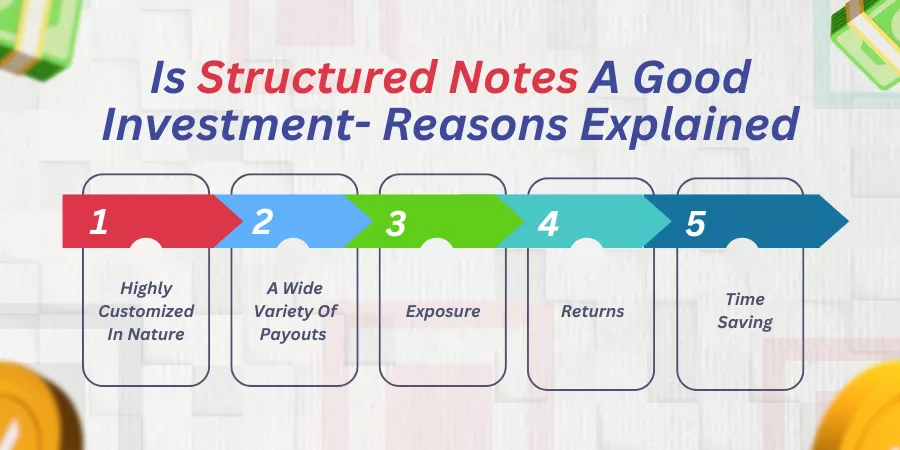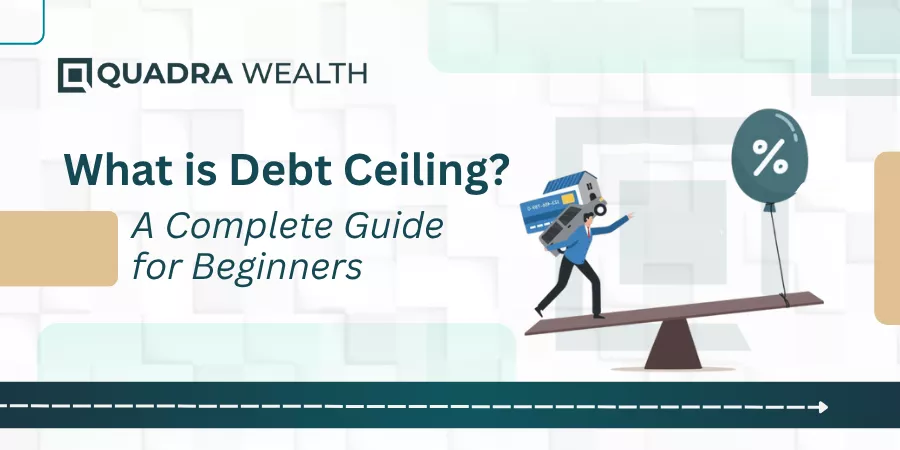Introduction
Often investors are promised tailored financial strategy and higher returns when investing in structured notes. But is that true? What about market fluctuations, tax regulations, credit risk, and liquidity issues? At what length does your investment get impacted? It might be challenging for you to discern whether the promises are certain or it might be just another jargon-filled term with vague benefits. Let us find out.
Structured products or structured notes are notes that combine debt with equity. The debt component protects an investor’s capital by providing downside protection. The debt component comprises traditional bonds, fixed-income securities, and mortgages, to name a few. This debt component is linked to an underlying asset or investment portfolio option.
The underlying assets include commodities, interest rates, currencies, stocks, shares, a basket of securities, and market indices.
Is structured notes a good investment plan? Well, let us move on to find that out.
Is Structured Notes A Good Investment- Reasons Explained

Let us find out good reasons as to how and why structured notes are good sources of investments for investors. Helping you through the pointers connected with the same:
Highly Customized In Nature
Structured notes are highly customized in nature. You can choose between bonds or mortgages. You can also choose the underlying assets linked to bonds as an investor.
You have assets like equities, shares, a basket of securities, commodities, market-indexed assets, and currencies to choose from. Based on the investor’s personalized interests, the notes can be customized as such. You can choose the type of structured note you want to go in for.
In a nutshell, this higher degree of customization to suit each investor’s risk tolerance is what drives structured products to an investor-friendly domain.
A Wide Variety Of Payouts
Investors can also choose from a wide variety of payout options that suit their wealth-generation objectives as such. You can choose notes that provide you a downside protection and at the same time provide you with a steady source of income. These notes are also known as income notes.
Or, you can have the financial product tailormade in such a way that you have an upside potential to gain from increased equity/ derivative valuations. These notes are also known as growth notes. For fixed-income seekers, structured notes allow fixed coupon payouts associated with bonds, credit notes, and govt-backed mortgages.
Likewise, you can choose your investment portfolio based on the potential risk tolerance that you can handle. Structured notes may have to be evaluated beforehand and that is the homework that must be carried out from the investor’s end.
Exposure
As has already been discussed, structured notes are predominantly hybrid instruments that combine an optimal mix of debt and equity. Say for instance, you can have a note that is designed in such a way that the debt or bond is linked to the performance of a single stock, and the earnings are based on the long-term valuation of how the stock does at the market.
Structured notes can also be linked to market indexes, credit notes, commodities, and currencies.
Therefore, as an investor when you invest your funds in structured products, the notes offer you a wider exposure to different market segments in one go!
Returns
Under structured notes, you have the potential to oversee returns on investment the way you want to. For instance, you have income notes that are backed by 100% principal-protection which means the investor has every possibility of getting his initial investment back and the investor also earns interest earnings or fixed coupons the investment vehicle has to offer.
As you have different notes that have minimum barrier levels set, your income-earning potential does not diminish even if the performance of the underlying assets goes down by 15% or so.
Product issuers include swaps, buffer spreads, and derivative-infused options to put a tab on unprecedented losses the investor would otherwise be subjected to had he invested in the blue-chip shares as a direct investment.
Time-Saving
Unlike bonds or treasury notes wherein your funds may be locked in for 10-20 years in a row, most of the notes allow investors to quickly retrieve funds as and when needed.
For instance, you have autocallable notes that can be auto-called once the underlying prices of the assets reach par or go above the set barrier limits. The product issuers auto call in a period of 6 months to one year giving investors access to receive coupon payments too.
Therefore, a heavy waiting period is not involved in structured products as compared to bonds, fixed deposits, or mutual funds.
What Are The Downsides Or Cons That Are Connected With Structured Notes?
As you find that structured notes come to you with a whole lot of benefits, there are also potential downsides or cons connected with investing in these notes. What are they? Well, let us find out what they are:
Limited Liquidity
As you can see, structured products are newly introduced in the financial market. Therefore, as investors, you may understand that these products are not as widely traded as other popular forms of investment products. Say, for instance, stocks, bonds, or ETFs. Therefore, investors may have to wait until the notes mature to receive their principal money and the final payouts.
These notes are also highly customized in nature. Therefore, it becomes harder to find buyers who may be interested in buying the notes from you.
As the notes are not standard financial products that find an immediate market for buying or selling them, the liquidity aspect in structured notes becomes a complicated ball game indeed.
Pricing Rigidity
The final pricing of structured products is done using a matrix method. Therefore, the final price at the time of maturity and coupon payouts are not fixed or determined as in the case of mutual funds or fixed deposits.
In other words, the final payouts comprising principal and returns are figures arrived at on the day of observation. Therefore, investors themselves cannot gauge how much they receive once the notes mature. Therefore, it is to be understood that if the prices of the underlying assets go bottom down or trade sporadically, then investors may lose their principal money and the final coupon payouts too.
Say, for instance, you have an income note that has Proctor and Gamble (P&G) as the underlying asset and this note matures over 5 years. In this scenario, when P&G does well and the prices of the shares go above threshold limits as the note reaches, 4 years and 11 months, then the investors can receive all of their coupon payments.
On the other hand, when the market value for P&G slumps and the prices crash badly in the interim of the five years, then investors may not only lose their coupon payouts but also a part of their initial investment.
And, as you cannot sell these notes easily, you may have to hold your notes until they mature. Therefore, the risk of losing your potential capital money is always there on the cards.
Assessing Call Risk
Some of the structured products come to you with a built-in call-off option. This is particularly the case with autocallable notes. Therefore, the product issuer may call off your income notes even before they mature and may offer you the principal plus coupons. This can be a fantastic option indeed.
However, as an investor, when you may want to re-invest the money into buying other coupon bonds or other regular bonds, the interest rates may dip or fall. Or, you may be subject to other volatile conditions the market throws up at you.
Therefore, a call risk option is a factor that cannot be simply brushed aside.
Fees
As the structure of notes follows a complex pattern, it is an expensive affair for product issuing firms to design the notes in favor of the investor’s risk tolerance ratio. Therefore, the cost of curation of these notes may turn out to be more expensive over bonds, mutual funds, or etfs.
Tax implications
Although notes have structured bond components, the income you receive from notes is treated as regular income and you may be taxed accordingly. It is to be noted that the income returns you receive from notes may not have lower slabs of taxation as is the case when incomes are treated as capital gains. And, this difference can have a toll on the investors as such.
However, you can receive guidance from your legal team or tax advisor as to how different slabs of income are treated. The US Securities and Exchange Commission or SEC also suggests investors go through the prospectus of your financial documents to understand the tax implications of the investment plan that you have chosen.
Understand The Regulatory Compliance Of Structured Notes
Investors may have to abide by statutory and regulatory compliance norms concerning financial products like structured notes. You have regulatory bodies like the US Securities and Exchange Commission (SEC), Financial Industry Regulatory Authority (FINRA), and European Securities and Markets Authority (ESMA) who lay down the guidelines that investors and product issuing firms may have to follow.
The disclosure documents must also be signed and dated by parties concerned with the issuance and purchase of the notes. For structured products, you have detailed prospectuses that typically outline the terms and conditions, potential risks, and potential returns of the note. This is for the global markets.
In European markets, you are provided with a Key Information Document or KID, post issuance of structured notes. The key document essentially contains the overall features of the product you have purchased and contains info on costs and risk factors too.
The regulatory firms also conduct audits and checks from time to time so that product issuers do not spread misleading information to investors and these firms comply with the regulatory or statutory requirements that are mandated as stipulated by the governing authorities.
What Are The Things The Investor Must Consider Before Investing In Structured Notes?

These are the following aspects an investor must consider before investing in structured notes. Let us figure out what the essential protocols are:
Finding Out If You Are Suitable Or Not
As an investor, you must certainly find out if you are a suitable player to deal with notes or not. You can choose structured products to be designed based on the investment goals you have in mind. The product issuers will then assess the risk tolerance that you are independently capable of handling. Your immediate or current financial situation is also assessed at the point of sale and then the notes are designed by investment-grade banks and large institutional corporations for investors as such.
Do You Have A Thorough Knowledge Of How Financial Products Work?
As an investor, you must do a thorough research analysis beforehand. This way, you have cutting-edge exposure to how different forms of financial products work.
You can create product cheat sheets and input simulated data figures to essentially guage if you receive the potential income you are looking for from a structured plan that stands chosen.
As the last step, you must approach a financial advisor to get your risk profiling done. In a nutshell, only if you know how financial products work, can you have cues on whether a chosen investment product can work to your advantage or not.
Analyzing The Risk Factors That Are Involved With Structured Products
As structured notes combine debt with equity, these are complex financial products to learn or understand. As an investor, you may be subject to a whole fleet of credit, market, and liquidity risks to name a few. Therefore, you must evaluate the risk factors that are connected with volatile structured products so that you know that you are stepping on the right foot forward and not hitting blind spots as such. Therefore, analysis of risk factors beforehand can help you invest in the right form of structured products that work to your advantage.
The Bottom Line
Although structured products come to you with a wide range of lucrative benefits, you also have credit and market risks that can erode the investor’s capital or principal amount. As the notes link their gains to underlying derivative components, the liquidity may not be all that sound. The note matures on product issuer calls too.
The fixed returns based on the bond component are camouflaged with a volatile group of assets in the stock market which makes structured plans a little complex to learn of understand.
Every investment plan has its own set of pros and cons and the investor must have enough risk profiling done under his sleeve to cope with the volatilities of equity or other financial markets.
You must know the risks beforehand and then venture into signing on the dotted lines.
What are your thoughts on this?






